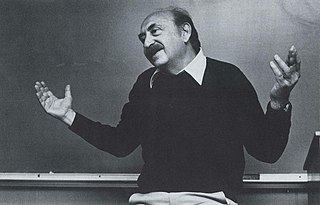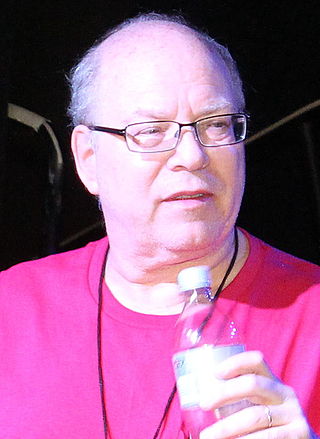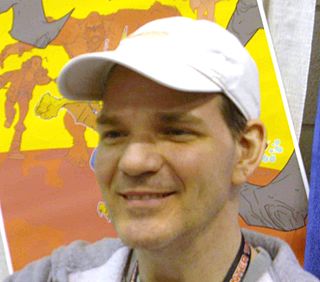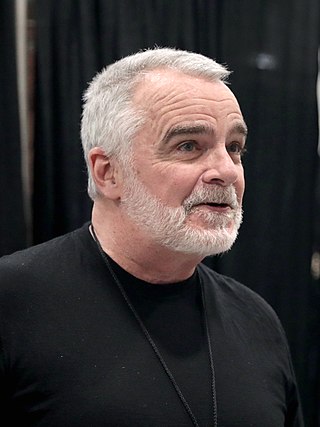
Rodan is a fictional monster, or kaiju, which first appeared as the title character in Ishirō Honda's 1956 film Rodan, produced and distributed by Toho. Following its debut standalone appearance, Rodan went on to be featured in numerous entries in the Godzilla franchise, including Ghidorah, the Three-Headed Monster, Invasion of Astro-Monster, Destroy All Monsters, Godzilla vs. Mechagodzilla II and Godzilla: Final Wars, as well as in the Legendary Pictures-produced film Godzilla: King of the Monsters.

Saul Bass was an American graphic designer and Oscar-winning filmmaker, best known for his design of motion-picture title sequences, film posters, and corporate logos.

Pablo Ferro was a Cuban-American graphic designer, film titles designer, and founder of Pablo Ferro Films.

Arthur Adams is an American comic book artist and writer. He first broke into the American comic book industry with the 1985 Marvel Comics miniseries Longshot. His subsequent interior comics work includes a number of Marvel's major books, including The Uncanny X-Men, Excalibur, X-Factor, Fantastic Four, Hulk, and Ultimate Comics: X, as well as books by various other publishers, such as Action Comics, Vampirella, The Rocketeer, and The Authority. Adams has also illustrated books featuring characters for which he has a personal love, such as Godzilla, the Creature from the Black Lagoon, and Gumby, the latter of which garnered him a 1988 Eisner Award for Best Single Issue.
Terrence "Terry" Kavanagh is an American comic book editor and writer.

Allen L. Milgrom is an American comic book writer, penciller, inker and editor, primarily for Marvel Comics. He is known for his 10-year run as editor of Marvel Fanfare; his long involvement as writer, penciler, and inker on Peter Parker, The Spectacular Spider-Man; his four-year tenure as West Coast Avengers penciller; and his long stint as the inker of X-Factor. He often inks Jim Starlin's work. Milgrom is the co-creator of DC superhero Firestorm.

Todd Dezago is an American comic book writer best known for his collaborations with artist Mike Wieringo on The Sensational Spider-Man and their creator-owned fantasy series Tellos.

Howard Mackie is an American comic book editor and writer. He has worked almost exclusively for Marvel Comics and is best known as the co-creator of the Danny Ketch version of the Ghost Rider character.
Michel Gagné is a Canadian cartoonist.
Patrick Tatopoulos is a Greek-French production designer and director who lives and works in the United States. His designs have appeared in numerous motion pictures, including Pitch Black, Underworld, I, Robot, The Chronicles of Riddick, Independence Day, Bram Stoker's Dracula, Stargate, Spawn, Godzilla, Stuart Little, 300, I Am Legend, Man of Steel, Batman v Superman: Dawn of Justice, Justice League, 10,000 BC and Live Free or Die Hard.

Peter A. Ramsey is an American illustrator, storyboard artist, film director, screenwriter and film producer. He is best known for directing DreamWorks Animation's Rise of the Guardians (2012), becoming the first African American to direct a major American animated film, and co-directing Sony Pictures Animation's Spider-Man: Into the Spider-Verse (2018). For Spider-Man: Into the Spider-Verse, he became the first African American to be nominated for and win an Academy Award for Best Animated Feature.
Martin Elliot Isenberg is an American animation writer. He is best known for his role as co-story editor on Beast Machines and Transformers: Animated, and for his work on the 2003 Teenage Mutant Ninja Turtles series. He also wrote or co-wrote scripts for Ben 10, Danny Phantom, Gargoyles, Batman: The Animated Series, Action Man, Beetlejuice, The Mask, G.I. Joe: Renegades, X-Men: The Animated Series and Spider-Man: The Animated Series. From 1991-2003, he frequently collaborated with Robert N. Skir.
Garson Yu is a Hong Kong-born American designer. He is the founder and creative director of yU+co in Hollywood, California.
Robert N. Skir is a writer best known for his work in television animation on shows including X-Men, Gargoyles, Batman: The Animated Series, and Spider-Man. He co-created and served as Story Editor on programs including Transformers: Beast Machines, Extreme Ghostbusters, Godzilla: The Series, and DinoSquad, and co-developed the series X-Men: Evolution. From 1991 to 2003, he frequently collaborated with Marty Isenberg.
Amalgamated Dynamics, Inc. (ADI) is an American special effects company specializing in animatronics and prosthetic make-up, headquartered in Chatsworth, California. It was founded in 1988 by Stan Winston alumni Tom Woodruff Jr. and Alec Gillis who hails from Phoenix, Arizona. Notable work includes Death Becomes Her, for which they won an Academy Award for Best Visual Effects, Starship Troopers, which was also nominated for an Oscar, and the practical creature effects seen in the Alien franchise from Alien 3 onward. Woodruff also portrays creatures in the films ADI works on, such as the Alien.

Sir Douglas Allen Booth, 3rd Bt, is an Anglo-American aristocratic screen writer and television producer.
Ashley Livingston Thorp is an illustrator, graphic designer, and creative director for feature films, commercial marketing, and print.
Karin Fong is a Los Angeles-based Emmy-award winning director and designer. Fong is an originator of Imaginary Forces, which is a design studio and creative agency.








